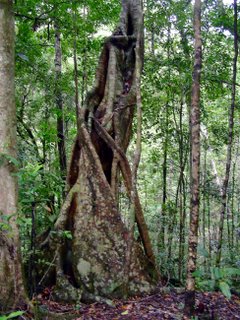 Although it looks like a crater, the 140-metre pit at Mt Hypipamee was blasted out of the granite by an explosion of volcanic gas. As the only diatreme in North Queensland, it is of great interest to geologists. What makes it even more unusual is that the surrounding area should be littered with granite blocks—after all, the bang took place less than three million years ago—but it isn't. Not a sausage. All that's left are pyroclastic basalts.
Although it looks like a crater, the 140-metre pit at Mt Hypipamee was blasted out of the granite by an explosion of volcanic gas. As the only diatreme in North Queensland, it is of great interest to geologists. What makes it even more unusual is that the surrounding area should be littered with granite blocks—after all, the bang took place less than three million years ago—but it isn't. Not a sausage. All that's left are pyroclastic basalts.  But it's not only the geology that's fascinating. The Crater is at a higher altitude than much of the Atherton Tablelands (1000 m), so its flora differs from that of nearby lakes Eacham and Barrine. The forest changes rapidly from typical tropical rainforest with figs and vines to wet eucalypt forest dominated by rose gums (Eucalyptus grandis).
But it's not only the geology that's fascinating. The Crater is at a higher altitude than much of the Atherton Tablelands (1000 m), so its flora differs from that of nearby lakes Eacham and Barrine. The forest changes rapidly from typical tropical rainforest with figs and vines to wet eucalypt forest dominated by rose gums (Eucalyptus grandis). Even more importantly, the national park is the type locality of a small and dull-looking snail—Craterodiscus pricei. Described by McMichael in 1959, this animal was shovelled in with the Helicarionidae and Camaenidae before being assigned to the Corillidae (sometimes called Plectopylidae). The last two moves were supported by a very, very small amount of evidence. In both cases, the decisions were based on the snail's lack of certain characteristics.
A large-scale molecular study has now placed Craterodiscus more or less back where it started. Plus ça change, plus c'est la même chose.
Read more about Corillidae in the great scheme of snail systematics
Wade, C.M., Mordan, P.B. & Naggs, F. (2006) Evolutionary relationships among the pulmonate land snails and slugs (Pulmonata: Stylommatophora). Biological Journal of the Linnean Society 87 (4): 593–610.
And about the Crater
Lava News (PDF)